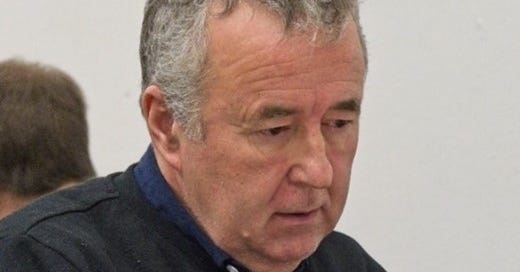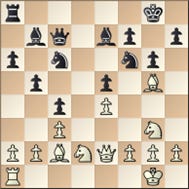Nigel Davies became a GM in 1993 and has enjoyed success as a chess author with 22 books published, and as a FIDE trainer through his tigerchess.com website. In 2022 he came back to the ECF after seven years with the Welsh Chess Union.
Few players in their early sixties have decided to get back into high-level tournaments after a few years’ absence. What made you throw your hat into the ring and how is OTB chess going?
I’ve barely played for the last two decades: it’s difficult to be playing lots of chess with parenthood, especially when I was a chess parent. My return was prompted largely by my son going to university. I was curious as to whether it was possible to make a successful comeback. Thus far the best that can be said is that it’s a ‘work in progress’, but things are gradually improving!
Tell us about the recent January 4NCL Harrogate Congress in which you shared first place with five players in a strong Open field.
This was my best result in a standard time limit tournament since my return, and I also played a couple of decent games. People were surprised that I agreed to an early draw as White against Paul Townsend, but he’s a tough opponent and I just wanted to finish first.
After seven years of being with the Welsh Chess Union, you rejoined the ECF last year. Why did you come back to the ECF?
I had hoped that the Welsh Chess Union would place more value on my presence, but I didn’t hear from them much. Meanwhile the ECF has gone through quite a renaissance since I left, with new events having been organised and opportunities for English players.
You are a prolific chess writer (22 books) and a Senior FIDE Trainer (tigerchess.com) with excellent reviews in both those fields. What are the key qualities that make a good chess coach?
I would say a love of the game, an understanding of the needs of those you’re coaching, and good communication skills.
Which people have had the most positive influence on your chess career, playing, writing and coaching?
As far as playing is concerned, I’d say Bob Wade and Lev Psakhis were two major influences. I was also helped a lot by people whose books I’ve read, particularly Emanuel Lasker, Mikhail Botvinnik, Paul Keres, Richard Réti, Ray Keene and Mikhail Shereshevsky. Richard James influenced me a lot with coaching, especially when it came to teaching my son.
It’s 30 years since you became a GM. How has the game
changed over those years?
The effect of computers has been massive, not just with engines and databases but in how they’ve aided learning. In particular, the standard of opening play has risen massively, and this is something I’ve been struggling with.
In 2020 you got a first-class honours BSc degree in computing from Edge Hill University. Tell us about the academic paper you wrote ‘Predicting Success in Competitive Chess’ and whether you intend to take your computing degree further?
It was a study of FIDE rating data to see if having a high rating at particular ages was a predictor of future progress. Essentially it wasn’t, largely due to the very high dropout rate of young players who are believed to be ‘talented’. On the other hand, I did find statistical significance in players who reached the cusp of adolescence as strong and established players, with ratings around 2200.
Please show us an annotated version of one of your favourite games.
(2840) Kaminski, Marcin (2400) - Davies, Nigel R (2505) [C86]
Liechtenstein Open Liechtenstein (7), 1993
This game was played in the year that I scored two GM norms and got the title. It was also a watershed from a stylistic point of view in that I was prepared to meet 1.e4 with 1...e5 rather than use my habitual Modern Defence.
1.e4 e5 2.Nf3 Nc6 3.Bb5 a6 4.Ba4 Nf6 5.0–0 Be7 6.Qe2 b5 7.Bb3 0–0 8.c3 d6 9.Rd1 Na5 10.Bc2 c5 11.d4 Qc7 12.dxe5 This is not dangerous for Black, as White will not be able to establish a piece on d5. On the other hand, Black may gain space with ...c5–c4.
12...dxe5 13.Nbd2 Rd8 14.Nf1 Rxd1 15.Bxd1 Bb7 16.Bc2 c4 17.Ng3 g6 18.Bg5 Nc6 19.Nd2 This meets with a strong reply.
White should play 19.a4, with approximate equality.
19...Nh5 20.Bxe7 Nf4 21.Qf3 Nxe7 22.Ne2 (White doesn't sense the danger to his position.)
(22.Ndf1 would have been better.)
22...Rd8 23.Qe3 And this loses because of Black's unexpected reply.
23.Nf1 was the best, though Black is better after 23...Nd3.
23...Nxg2! 24.Kxg2 Nf5 (It turns out that the queen cannot protect the knight on d2, so Black wins material.)
25.Qg5 h6 26.Qf6 Rxd2
0–1
You also play table tennis at club level. Is there a connection between bullet chess and table tennis, in that in both games you have to make decisive shots and moves with no time to think?
Well, I don’t play bullet chess so I wouldn’t know, but it does seem that there’s quite a crossover between the two games. I should also point out that my table tennis is very weak, and I’ve now taken a break through sheer embarrassment and the time it consumes!
Tell us about some of your chess coaching achievements.
I worked with some young players who went on to achieve great things, a bit with Matthew Sadler and Darshan Kumaran and then more extensively with Ronen Har-Zvi. However, I’m more satisfied with my work with older club players, who usually make progress with me because of my structured teaching program. I should also mention my favourite student is my son Sam, who I taught from zero to his reaching over 2000 strength. He has taken a break from chess during the last couple of years, but I’m hopeful that he will return.
Do you play online rapidplay and/or blitz?
Not very much, and when I do it’s under an anonymous account. Having said that, I use Lichess a lot because of its ‘study’ feature; it’s essentially an online database and works beautifully.
How can 1700 players get better? (I’m asking on behalf of a friend).
Make sure you do regular endgame and tactics practice and play normal openings. If you want to learn positional play, then join tigerchess.com and take lessons with me!








